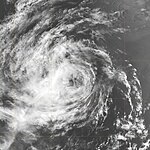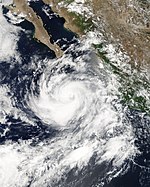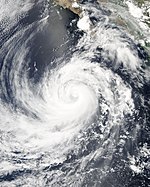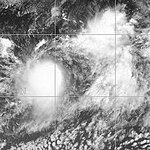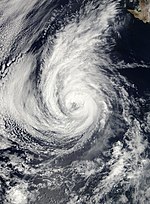User:Cyclonebiskit/2005 Pacific hurricane season
| Cyclonebiskit/2005 Pacific hurricane season | |
|---|---|
 Season summary map | |
| Seasonal boundaries | |
| First system formed | May 17, 2005 (Adrian) |
| Last system dissipated | October 20, 2005 (Sixteen-E) |
| Strongest storm | |
| Name | Kenneth |
| • Maximum winds | 135 mph (215 km/h) |
| • Lowest pressure | 947 mbar (hPa; 27.97 inHg) |
| Seasonal statistics | |
| Total depressions | 17 |
| Total storms | 15 |
| Hurricanes | 7 |
| Major hurricanes (Cat. 3+) | 2 |
| Total fatalities | 1 direct, 6 indirect |
| Total damage | $12 million (2005 USD) |
| Related articles | |
The 2005 Pacific hurricane season was a near average season that produced 17 tropical cyclones. It officially started on May 15 and ended on November 30, dates which conventionally delimit the period during which most tropical cyclones form in the northeast Pacific Ocean. The first tropical cyclone, Hurricane Adrian, developed on May 17, while the last storm Tropical Depression Sixteen-E, dissipated on October 20. During the year, a total of 17 tropical cyclones, 15 tropical storms, 7 hurricanes and 2 major hurricanes formed. The most intense hurricane, Hurricane Kenneth remained out over open waters for the duration of its existence. However, the remnants of the storm caused minor flooding on the Island of Hawaii. September was the most active month of the year, as 6 of the 17 tropical cyclones formed during this time.
Very few storms impacted land throughout the season. Hurricane Adrian was the only landfalling system. It struck El Salvador as a dissipating tropical depression after rapidly weakening from hurricane status. Mudslides and strong winds in El Salvador and heavy rains in Nicaragua and Guatemala led to seven fatalities. Tropical Storm Dora and Hurricane Hilary brought tropical storm force winds to coastal Mexico, although no damage was reported. The remnants Tropical Depression One-C caused heavy rainfall on the Island of Hawaii, peaking at 8.8 in (223.52 mm). The remnants of Hurricane Kenneth also impacted Hawaii, leading to heavy rains amounting up to 12 inches (305 mm). In all, the storms caused about $12 million (2005 USD) in damage and seven fatalities.
Pre-season forecasts[edit]
| Source | Date | Named storms |
Hurricanes | Major hurricanes |
| Eastern | Average | 15.3 | 8.8 | 4.2 |
| Eastern | 16 May, 2005 | 11 – 15 | 6 – 8 | 2 – 4 |
| Eastern | Actual activity | 15 | 7 | 2 |
| Central | Average | 4 – 5 | 1 | - |
| Central | May 16, 2003 | 2 – 3 | - | - |
| Central | Actual activity | 2 | 2 | 1 |
The U.S. National Oceanic and Atmospheric Administration predicted a below average season, with 11-15 named storms forming, 6-8 becoming hurricanes, and 2-4 becoming major hurricanes (Category 3 or higher on the Saffir-Simpson Hurricane Scale). This forecast was based on a neutral El Niño/La Niña cycle. Also, due to the relationship between the Atlantic basin activity and the eastern Pacific basin activity, there was a further assurance in an inactive season as the Atlantic was forecast to feature an above average season.[1]
The forecast for the central North Pacific was for a below-average season, with only two or three storms impacting the region, below the normal four to five.[2]
Storms[edit]

Hurricane Adrian[edit]
| Category 1 hurricane (SSHWS) | |
| Duration | May 17 – May 21 |
|---|---|
| Peak intensity | 80 mph (130 km/h) (1-min); 982 mbar (hPa) |
On May 15, the hurricane season began in the Eastern Pacific basin, which is the area of the northern Pacific Ocean east of 140ºW.[3] A few days before the official start to the season, a broad area of low pressure developed over Central America and moved into the Pacific basin. The low became the first tropical depression on May 17 about 460 miles (740 km) west-southwest of El Salvador. The depression, quickly strengthened into Tropical Storm Adrian that night. Adrian gradually intensified while moving in an unusual northeast direction due to a strong trough located north of the storm. On May 19, Adrian was briefly upgraded to a hurricane about 85 mi (135 km) off the coast of El Salvador, closer than any Pacific hurricane on record. However, Adrian rapidly weakened due to wind shear and by its landfall near the Gulf of Fonseca as a tropical depression, and dissipated shortly after.[4] When Adrian made landfall on May 20, it became the earliest landfalling tropical cyclone in Central America.[5]
Tropical Storm Biatriz[edit]
| Tropical storm (SSHWS) | |
| Duration | June 21 – June 24 |
|---|---|
| Peak intensity | 50 mph (85 km/h) (1-min); 1000 mbar (hPa) |
After a month of inactivity[6], the second tropical depression of the season formed on June 21 about 385 mi (620 km) south of Zihuatanejo, Mexico. The depression intensified into Tropical Storm Beatriz the next morning. Beatriz moved to the northwest, away from land, while intensifying. The storm reached its peak intensity late that night before before slow weakening took place. By the night of June 23, Beatriz was downgraded to a tropical depression, and not long after was declared a remnant low-pressure area. The remnant low lingered for a few days before dissipating over open waters.[7]
Tropical Storm Calvin[edit]
| Tropical storm (SSHWS) | |
| Duration | June 26 – June 29 |
|---|---|
| Peak intensity | 50 mph (85 km/h) (1-min); 1000 mbar (hPa) |
Late on June 26, just as the remnants of Beatriz were dissipating[7], Tropical Depression Three-E formed 330 mi (530 km) south-southeast of Acapulco, Mexico. The depression was upgraded to Tropical Storm Calvin the next morning as it neared the southwest Mexican coastline. A gradual turn to the northwest took place as Calvin intensified. Paralleling the coastline, wind shear caused Calvin to weaken. By June 28, Calvin was downgraded to a tropical depression and further deterioration of the depression led to it being declared a remnant low that night. The remnants of Calvin moved in a general northwest motion out to sea and dissipated on July 3.[8]
Tropical Storm Dora[edit]
| Tropical storm (SSHWS) | |
| Duration | July 4 – July 6 |
|---|---|
| Peak intensity | 45 mph (75 km/h) (1-min); 1003 mbar (hPa) |
On June 18, a new tropical wave moved off the coast of Africa. This wave was devoid of almost all its convection as it traversed the atlantic. It crossed into the eastern Pacific on July 1. It gradually became better organized and by July 4, it was determined that Tropical Depression Four-E had formed 145 mi (235 km) south of Acapulco, Mexico. Tropical Storm watches and warnings were issued as it neared the Mexican coast. On the afternoon of July 4, the depression quickly strengthened and was determined to have become Tropical Storm Dora that day. It came very close to the coast before turning towards the northwest, paralleling the coastline later for most of July 5, dropping heavy rainfall on the region. As it moved away from the coast, all watches were cancelled as Dora weakened to a tropical depression. Further weakening took plact later in the day and Dora degenerated into a remnant low. The low continued moving towards the northwest before dissipating the next day.[9]
Tropical Storm Eugene[edit]
| Tropical storm (SSHWS) | |
| Duration | July 18 – July 20 |
|---|---|
| Peak intensity | 70 mph (110 km/h) (1-min); 989 mbar (hPa) |
The beginnings of Tropical Storm Eugene can be traced back to a tropical wave which entered the Caribbean Sea on July 10. The wave gradually organized as it traveled towards the west, and entered the eastern Pacific basin on July 14. The wave spawned Tropical Depression Five-E on July 17 about 305 mi (490 km) south of Manzanillo, Mexico. The storm was upgraded to Tropical Storm Eugene the next morning and further intensification took place. Eugene was heading towards the coast of Baja California Sur and a tropical storm watch was issued respectively. However, less than a day later, the watches were cancelled as Eugene was no longer forecast to bring tropical storm conditions to the coast. By the afternoon of July 19, Eugene peaked just below hurricane status before encountering cooling waters. Weakening took place quickly and Eugene was downgraded to a tropical depression the next morning and further into a remnant low that afternoon. The low dissipated the next afternoon without impacting land.[10]
Tropical Depression One-C[edit]
| Tropical depression (SSHWS) | |
| Duration | August 3 – August 4 |
|---|---|
| Peak intensity | 30 mph (45 km/h) (1-min); 1008 mbar (hPa) |
In early August, an area of low pressure developed along the Intertropical convergence zone and slowly developed. By August 3, the low had developed sufficient convection to be declared Tropical Depression One-C while located 1,000 mi (1,610 km) southeast of the Island of Hawaii, the first tropical depression to form in the central Pacific basin. The depression failed to develop further as increasing wind shear and cooling waters caused the convection associated with the storm to diminish. The depression was declared a remnant low the next afternoon as only a swirl of clouds remained. The remnants of the depression later impacted the Island of Hawaii, leading to heavy rainfall up to 8.8 in (223.52 mm) in the town of Glenwood, Hawaii.[11]
Hurricane Fernanda[edit]
| Category 1 hurricane (SSHWS) | |
| Duration | August 9 – August 16 |
|---|---|
| Peak intensity | 85 mph (140 km/h) (1-min); 978 mbar (hPa) |
The origins of Hurricane Fernanda can be traced to a tropical wave which passed over Dakar, Senegal on July 25. Despite having well organized convection, further development did not occur. The wave entered the eastern Pacific on August 5. By August 9, the wave spawned Tropical Depression Six-E about 945 mi (1,520 km) west-southwest of Acapulco, Mexico. The depression quickly became tropical storm and a hurricane two days later. Fernanda reached its peak intensity a day later with winds of 85 mph (140 km/h) before strong wind shear weakened the storm. By August 15, Fernanda had weakened to a tropical depression, it degenerated into a remnant low shortly after.[12]
Tropical Storm Greg[edit]
| Tropical storm (SSHWS) | |
| Duration | August 11 – August 15 |
|---|---|
| Peak intensity | 50 mph (85 km/h) (1-min); 1000 mbar (hPa) |
Two days after the formation of Tropical Depression Nine-E,[12] a new tropical depression developed out of a tropical wave about 690 mi (1,110 km) south of Cabo San Lucas, Mexcio. Within six hours, the system intensified into Tropical Storm Greg as it tracked west-northwest and intensified. The following day, Greg attained its peak winds of 50 mph (85 km/h), despite moderate wind shear from nearby Hurricane Fernanda. Weakening steering currents caused the storm to later move in a slow, westward direction, during which convection weakened. Late on August 14, Greg became stationary as it weakened to a tropical depression. Within 24 hours, the system degenerated into a remnant low pressure system before being absorbed into the Intertropical Divergence Zone on August 16.[13]
Hurricane Hilary[edit]
| Category 2 hurricane (SSHWS) | |
| Duration | August 19 – August 25 |
|---|---|
| Peak intensity | 105 mph (165 km/h) (1-min); 970 mbar (hPa) |
Tropical Storm Irwin[edit]
| Tropical storm (SSHWS) | |
| Duration | August 25 – August 28 |
|---|---|
| Peak intensity | 50 mph (85 km/h) (1-min); 1000 mbar (hPa) |
Hurricane Jova[edit]
| Category 3 hurricane (SSHWS) | |
| Duration | September 12 – September 25 |
|---|---|
| Peak intensity | 125 mph (205 km/h) (1-min); 951 mbar (hPa) |
Hurricane Kenneth[edit]
| Category 4 hurricane (SSHWS) | |
| Duration | September 14 – September 30 |
|---|---|
| Peak intensity | 135 mph (215 km/h) (1-min); 947 mbar (hPa) |
Tropical Storm Lidia[edit]
| Tropical storm (SSHWS) | |
| Duration | September 17 – September 19 |
|---|---|
| Peak intensity | 40 mph (65 km/h) (1-min); 1005 mbar (hPa) |
Hurricane Max[edit]
| Category 1 hurricane (SSHWS) | |
| Duration | September 18 – September 22 |
|---|---|
| Peak intensity | 85 mph (140 km/h) (1-min); 981 mbar (hPa) |
Tropical Storm Norma[edit]
| Tropical storm (SSHWS) | |
| Duration | September 23 – September 27 |
|---|---|
| Peak intensity | 60 mph (95 km/h) (1-min); 997 mbar (hPa) |
Hurricane Otis[edit]
| Category 2 hurricane (SSHWS) | |
| Duration | September 28 – October 3 |
|---|---|
| Peak intensity | 105 mph (165 km/h) (1-min); 970 mbar (hPa) |
Tropical Depression Sixteen-E[edit]
| Tropical depression (SSHWS) | |
| Duration | October 15 – October 20 |
|---|---|
| Peak intensity | 35 mph (55 km/h) (1-min); 1005 mbar (hPa) |
Impact[edit]

During the season, tropical cyclones collectively caused 7 fatalities and about $12 million in damage (2006 USD).[nb 1]
Central America was impacted by one tropical cyclone, former Hurricane Adrian which made landfall in Honduras, one of only six landfalls in Central America.[4] Adrian had minor effects in Honduras, only a few poorly constructed building were destroyed and minor floods were reported and there were no known fatalities associated with the storm.[14] In El Salvador, rains from Adrian led to numerous landslides and flash floods, mainly along coastal areas. Fallen trees were reported throughout the country.[15] The floods prompted officials to shut down roads to keep people out of harms way.[16] Heavy rains up to 16.4 inches (418.6 mm) caused several landslides which damaged roads.[17] Two people were also killed in a mudslide.[18] Two more deaths took place, one due to a plane crash caused by strong winds, the other caused by flooding.[19] In all, damages in El Salvador totaled to $12 million (2005 USD; $13.2 million 2008 USD).[20] In Guatemala, two people were killed after rains ahead of Adrian caused a ditch to cave in on them.[21] One person was killed due to flooding in Nicaragua.[4]
Mexico, a country frequently impacted by tropical storms and hurricanes, was affected by three storms during 2005, none of which made landfall.[6] Tropical Storm Dora tracked very close to the southwest coast of Mexico, causing rain along the coastal areas.[9] Rainfall of 2.3 in (60 mm) fell across the areas where Dora made its closest approach to land. Rainfall peaked in this area at 6.5 in (166 mm).[22] However, no damage was reported.[9] The second storm to affect Mexico, Hurricane Hilary, briefly brought tropical storm-force winds to Manzanillo, Mexico. No damage was caused by the winds.[23] Hurricane Otis produced rough surf off the cost of Baja California Sur,[24] ranging from 8–10 ft (2–3 m),[25] and heavy rains, amounting up to several inches, led to minor flooding.[24] About 1 in (25.4 mm) of rain was recorded in Cabo San Lucas. [25]
The remnants of Tropical Depression One-C caused heavy rains on the Island of Hawaii over a four day span from August 6 to 10. Rainfall totaled up to 8.8 in (223.52 mm) in the town of Glenwood, Hawaii.[11] Large swells generated by Hurricane Jova produced surf of 8–12 ft (2–3.6 m) on eastern-facing coasts of the Hawaiian Islands.[26] At Nu‘uanu Pali on Oahu, a gage recorded a total precipitation of 10.25 inches (260.4 mm) from Hurricane Kenneth.[27] Peak rainfall totals on Oahu included reports of up to 12 inches (305 mm), which puts Kenneth in a three-way tie for ninth on Hawaii's rainiest tropical cyclones list.[11] Large swells churned up by the hurricane generated surf of 8–10 ft (2–3 m) that crashed ashore on September 30 along the east shores of the islands of Hawaii, Kauai, Molokai, Maui, and Oahu. No reports of injuries or serious damage were received.[28]
Season impact[edit]
This is a table of the storms in 2005 and their landfall(s), if any; the table does not include storms that did not make landfall, which is defined as the center of the storm moving over a landmass. Deaths in parentheses are additional and indirect (an example of an indirect death would be a traffic accident), but are still storm-related. Damage and deaths include totals while the storm was extratropical or a wave or low.
| Saffir–Simpson scale | ||||||
| TD | TS | C1 | C2 | C3 | C4 | C5 |
| Storm name |
Dates active | Storm category
at peak intensity |
Max wind (mph) |
Min. press. (mbar) |
Landfall(s) | Damage (millions USD) |
Deaths | |||
|---|---|---|---|---|---|---|---|---|---|---|
| Where | When | Wind
(mph) | ||||||||
| Adrian | May 17 – May 21 | Category 1 hurricane | 80 | 982 | Gulf of Fonseca | May 20 | 25 | 12 | 1 (6) | |
| Beatriz | June 21 – June 24 | Tropical storm | 50 | 1000 | none | 0 | 0 | |||
| Calvin | June 26 – June 29 | Tropical storm | 50 | 1000 | none | 0 | 0 | |||
| Dora | July 4 – July 6 | Tropical storm | 45 | 1003 | none | Minimal[nb 2] | 0 | |||
| Eugene | July 18 – July 20 | Tropical storm | 70 | 989 | none | 0 | 0 | |||
| One-C | August 3 – August 4 | Tropical depression | 30 | 1008 | none | 0 | 0 | |||
| Fernanda | August 9 – August 16 | Category 1 hurricane | 85 | 978 | none | 0 | 0 | |||
| Greg | August 11 – August 16 | Tropical storm | 50 | 1000 | none | 0 | 0 | |||
| Hilary | August 19 – August 25 | Category 2 hurricane | 105 | 970 | none | 0[nb 3] | 0 | |||
| Irwin | August 25 – August 28 | Tropical storm | 50 | 1000 | none | 0 | 0 | |||
| Jova | September 12 – September 25 | Category 3 hurricane | 125 | 951 | none | 0 | 0 | |||
| Kenneth | September 14 – September 30 | Category 4 hurricane | 135 | 947 | none | Minimal[nb 4] | 0 | |||
| Lidia | September 17 – September 19 | Tropical storm | 40 | 1005 | none | 0 | 0 | |||
| Max | September 18 – September 22 | Category 1 hurricane | 85 | 981 | none | 0 | 0 | |||
| Norma | September 23 – September 27 | Tropical storm | 60 | 997 | none | 0 | 0 | |||
| Otis | September 28 – October 3 | Category 2 hurricane | 105 | 970 | none | 0 | 0 | |||
| Sixteen-E | October 15 – October 20 | Tropical depression | 35 | 1005 | none | 0 | 0 | |||
| Season Aggregates | ||||||||||
| 17 cyclones | May 17 – October 20 | 135 | 947 | 1 landfall | 12 | 1 (6) | ||||
Storm names[edit]
The following names were used for named storms that formed in the northeast Pacific in 2005. This is the same list that was used in the 1999 season. Names that were not assigned are marked in gray. There were no names retired by the WMO in the spring of 2006; therefore, the same list will be reused in the 2011 season.
|
No central Pacific names were used; the first name used would have been Ioke.
Retirement[edit]
During the 61st Interdepartmental Hurricane Conference, the Hawaii State Civil Defense requested the retirement of the name Kenneth, citing that the storm had become memorable due to threat or damage.[29] However, the World Meteorological Organization did not approve the request, and the name remains on the tropical cyclone naming list[30]
See also[edit]
- List of Pacific hurricanes
- List of Pacific hurricane seasons
- 2005 Atlantic hurricane season
- 2005 Pacific typhoon season
- 2005 North Indian Ocean cyclone season
- South-West Indian Ocean cyclone seasons: 2004–05, 2005–06
- Australian region cyclone seasons: 2004–05, 2005–06
- South Pacific cyclone seasons: 2004–05, 2005–06
Notes[edit]
- ^ The cumulative damage and fatality figures were obtained by summing the figures from the impact section.
- ^ Tropical Storm Dora paralleled the western coastline of Mexico, but the center did not make landfall.
- ^ Hurricane Hilary briefly caused tropical storm-force winds in Manzanillo, Mexico after the storm rapidly expanded in size.
- ^ The remnants of Hurricane Kenneth passed over the Hawaiian Islands, bringing heavy rains and flooding.
References[edit]
- ^ Climate Prediction Center, NOAA (2005-05-16). "NOAA Releases East Pacific Hurricane Season Outlook: Below Normal Seasonal Activity Expected in 2005". National Oceanic and Atmospheric Administration. Retrieved 2006-08-18.
{{cite web}}: Check date values in:|year=(help) - ^ Climate Prediction Center, NOAA (2005-05-16). "NOAA Expects Below Average Central Pacific Hurricane Season: Hawaii Observes Hurricane Preparedness Week May 15-21". National Oceanic and Atmospheric Administration. Retrieved 2006-08-18.
{{cite web}}: Check date values in:|year=(help) - ^ Atlantic Oceanographic and Meteorological Laboratory, Hurricane Research Division. "Frequently Asked Questions: When is hurricane season?". National Oceanic and Atmospheric Administration. Retrieved 2008-10-22.
- ^ a b c Richard D. Knabb (2005-11-24). "Tropical Cyclone Report: Hurricane Adrian" (PDF). National Hurricane Center. Retrieved 2008-10-22.
- ^ NASA/Goddard Space Flight Center (2005-05-24). "Tropical Storm Adrian Unusual In Timing And Path". ScienceDaily. Retrieved 2008-11-29.
- ^ a b Stewart, Beven, Avila, Franklin, Knabb, and Pasch (2005-12-01). "Northeastern Pacific Tropical Weather Summary for 2005". National Hurricane Center. Retrieved 2008-11-17.
{{cite web}}: CS1 maint: multiple names: authors list (link) - ^ a b James L. Franklin (2005-07-23). "Tropical Cyclone Report: Tropical Storm Beatriz" (PDF). National Hurricane Center. Retrieved 2008-10-22.
- ^ Jack Beven (2005-11-28). "Tropical Cyclone Report: Tropical Storm Calvin" (PDF). National Hurricane Center. Retrieved 2008-10-22.
- ^ a b c Stacy R. Stewart (2005-08-02). "Tropical Cyclone Report: Tropical Storm Dora" (PDF). National Hurricane Center. Retrieved 2008-10-22.
- ^ Richard J. Pasch (2006-04-05). "Tropical Cyclone Report: Tropical Storm Eugene" (PDF). National Hurricane Center. Retrieved 2008-10-22.
- ^ a b c Andy Nash, Victor Proton, Robert Farrell, and Roy Matsuda (2006-05-01). "2005 Tropical Cyclones in the Central North Pacific". Central Pacific Hurricane Center. Retrieved 2008-10-22.
{{cite web}}: CS1 maint: multiple names: authors list (link) - ^ a b Lixion A. Avila (2005-10-12). "Tropical Cyclone Report: Hurricane Fernanda" (PDF). National Hurricane Center. Retrieved 2008-11-29.
- ^ Richard D. Knabb (March 17, 2006). "Tropical Cyclone Report: Tropical Storm Eugene" (PDF). National Hurricane Center. Retrieved May 20, 2010.
- ^ Associated Press (2005-05-20). "Hurricane Adrian whacks El Salvador, then fizzles". USA Today. Retrieved 2008-11-29.
- ^ (in Spanish) "Informe De Perdidas y Daños Ocurridos Por Huracan Adrian" (PDF). National Service of Territorial Studies. 2005-06-08. Retrieved 2008-11-29.
- ^ (in Spanish) El Diario de Hoy (2005-05-19). "Cierran calles peligrosas". Nationales. Retrieved 2008-11-29.
- ^ (in Spanish) "Report of Landslides generated by Hurricane Adrian, El Salvador" (PDF). National Service of Territorial Studies. 2005. Retrieved 2008-11-29.
- ^ Alberto Barrera (2005-05-23). "Central America Storm Fades, Mudslides Feared". Reuters. Retrieved 2008-11-29.
- ^ "El Salvador, Honduras escape hurricane's wrath". CBC News. 2005-05-21. Retrieved 2008-11-29.
- ^ (in Spanish) El Diario de Hoy (2005-05-21). "Estiman $12 millones en pérdidas por Adrián". Nationales. Retrieved 2008-11-29.
- ^ Diego Mendez (2005-05-20). "El Salvador awaits Hurricane Adrian's arrival". Independent Online. Retrieved 2008-11-29.
- ^ (in Spanish) Geog. Cirilo and Bravo Lujano (2005). "Resumen de la Tormenta Tropical "Doa"" (PDF). National Meteorological Service. Retrieved 2008-11-17.
- ^ James L. Franklin (2006-02-06). "Tropical Cyclone Report: Hurricane Hilary" (PDF). National Hurricane Center. Retrieved 2008-12-18.
- ^ a b "Otis Fizzles Bit Still Ruffles Baja Fishing". Mexico Fishing News. 2005-10-03. Retrieved 2009-01-07.
- ^ a b George Landrum (2005-10-03). "Saltwater Fishing Reports in the Sea of Cortez/Pacific Ocean, Other for October 3, 2005". WebMasters International, Inc. Retrieved 2009-01-07.
- ^ "Event Record Details". National Climatic Data Center. Retrieved 2009-01-07.
- ^ Kevin R. Kodama (2005). "October 2005 Hawaii Precipitation Summary". NOAA/NWS Weather Forecast Office Honolulu. Retrieved 2008-12-18.
- ^ "Event Record Details". National Climatic Data Center. Retrieved 2008-12-18.
- ^ Interdepartmental Hurricane Conference (2007). "The Nation's Hurricane Program: An Interagency Success Story" (PDF). Retrieved 2007-12-29.
- ^ Dennis H. McCarthy (2007). "National Weather Service Instruction Tropical Cyclone Names and Pronunciation Guide" (PDF). Retrieved 2007-12-29.



